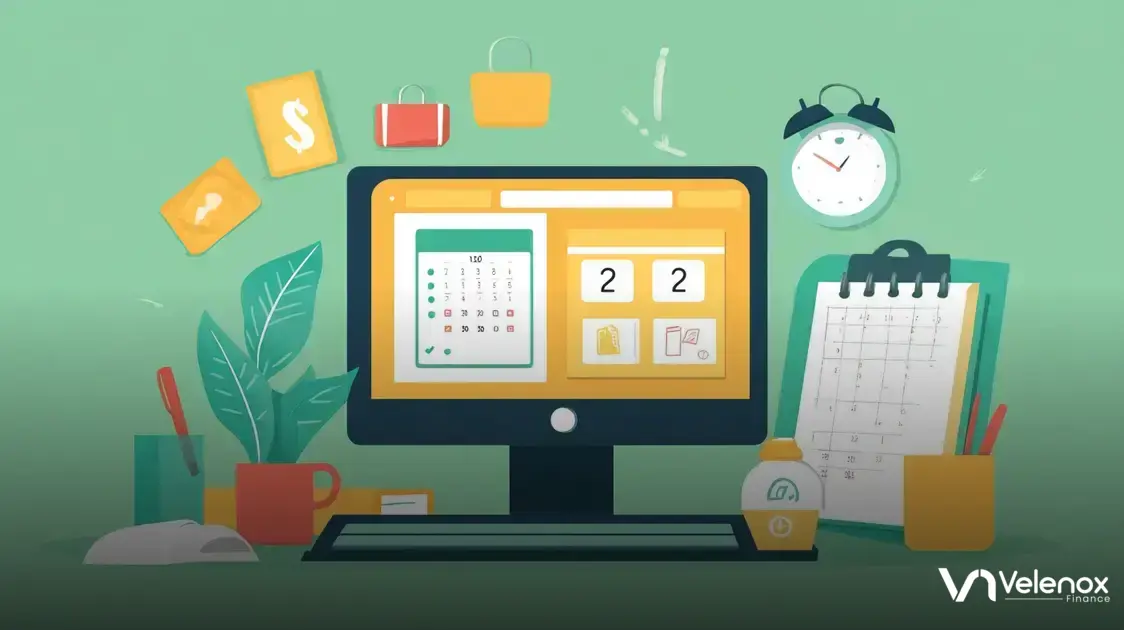Automated savings is a game-changer for those looking to enhance their financial health.
By streamlining the savings process, you can effortlessly grow your wealth while focusing on your daily life.
What is Automated Savings?
Automated savings refers to the process of setting up a system where a specific amount of money is automatically transferred from your checking account to a savings account.
This method can help you save money without having to actively think about it. It’s a straightforward way to build your savings over time without any hassle.
ADVERTISEMENT
Many banks and financial institutions offer options for automated savings.
For example, you can set a schedule for transfers, such as weekly or monthly, and choose the amount you wish to save.
With automated savings, your funds can grow gradually, allowing you to reach your financial goals faster.
How Does It Work?
When you enroll in an automated savings program, you typically need to link your checking account to your savings account.
Next, you select how much money you want to move and how often to do it. Once set up, the transfers occur automatically, meaning you don’t have to lift a finger!
This not only saves time but also encourages healthy savings habits.
You may be surprised to see how quickly your savings can accumulate when you don’t even think about it.
Types of Automated Savings
There are various types of automated savings options available.
For instance, some people opt for round-up savings accounts, where purchases are rounded up to the nearest dollar, and the difference is automatically deposited into savings.
Others set up a fixed amount to save from each paycheck, ensuring they save consistently.
Ultimately, automated savings can be a useful tool for anyone looking to improve their financial situation.
By removing the manual effort of saving, you can focus on other areas of your life while steadily building your financial future.
The Benefits of Automated Savings
Automated savings provides a range of benefits that make it an attractive option for anyone looking to improve their financial health.
One significant advantage is that it helps you save consistently without having to think about it.
By automatically transferring funds, you can build a savings buffer gradually, which can be invaluable during emergencies or for significant purchases.
1. Encourages Good Financial Habits
By setting up automated savings, you train yourself to prioritize saving money.
It creates a routine where saving becomes a regular part of your financial life, making it easier to stick to your budget.
2. Reduces the Temptation to Spend
When savings are automatic, you are less likely to dip into those funds for non-essentials.
Instead of having the money available in your checking account, it is transferred into savings where it can grow.
3. Builds Savings Faster
With automated savings, you can grow your savings more quickly than manual efforts.
Consistent contributions, even small amounts, can accumulate over time, helping you reach your financial goals sooner.
4. Sets and Achieves Goals
This savings approach encourages you to set specific financial goals, whether for a vacation, a new car, or an emergency fund.
Automated savings helps you stay on track towards these goals by making the process seamless.
5. Low Maintenance
Once your automated savings plan is established, it requires very little maintenance.
You can set it and forget it while watching your financial security grow without any extra effort.
6. Better Financial Planning
With automated savings, you can develop a more accurate understanding of your budget.
Seeing how much you save each month can help you make informed decisions about your spending and investments.
Overall, the benefits of automated savings are clear.
By integrating it into your financial plan, you can enjoy peace of mind while steadily working towards your financial future.
How to Set Up Automated Savings

Setting up automated savings is a straightforward process that can help you reach your financial goals without hassle. Here’s how to get started:
1. Choose the Right Account
Before you begin, decide where you want to save.
This could be a high-yield savings account, a separate savings account with your bank, or a specialized automated savings app.
Ensure the account offers a good interest rate and low fees.
2. Determine Your Savings Goals
Identify what you are saving for.
Whether it’s an emergency fund, a vacation, or a new gadget, having clear goals will guide how much and how often you save.
3. Set a Savings Amount
Decide how much money you want to set aside each time.
Start with an amount that feels comfortable and allows you to maintain your regular expenses without stress. Even small amounts can add up over time.
4. Decide on a Frequency
Choose how often you want the transfers to take place. Common frequencies include weekly, bi-weekly, or monthly.
Align this with your paycheck schedule for convenience.
5. Automate the Process
Log into your bank or savings app and set up the automation. Usually, you will find an option to schedule transfers under settings or payment options.
Enter the amount and schedule you’ve chosen.
6. Monitor Your Progress
Regularly check your savings account to see how your balance is growing.
This will keep you motivated and help you adjust your savings amount if necessary.
7. Adjust as Needed
Life changes, and so can your financial situation. Review your savings strategy every few months.
If you’re able to save more or need to save less, update your automated transfers accordingly.
Setting up automated savings can take just a few minutes, but the benefits will last for years.
By following these simple steps, you will be on your way to achieving your financial goals with ease.
Challenges of Automated Savings
While automated savings has many advantages, there are also challenges that individuals may face when utilizing this approach to saving.
Understanding these challenges can help you navigate them effectively.
1. Overdraft Risk
One of the significant risks of automated savings is the chance of overdrawing your checking account.
If your automated transfer occurs and there are insufficient funds, you might face overdraft fees from your bank.
It’s essential to ensure that you have enough money in your account before the transfer happens.
2. Inflexibility
Once you set up automated savings, it can be easy to forget about them.
This inflexibility may cause issues if you need to access your funds quickly or if your financial situation changes.
Regular monitoring is necessary to adjust your savings when needed.
3. Loss of Control
Automated savings might lead to a sense of losing control over your finances.
Some people may feel less engaged in their financial decisions if saving is automatic.
It’s essential to stay actively involved in your budgeting process to maintain awareness of your overall financial picture.
4. Temptation to Spend Remaining Balance
After setting automated savings, individuals may feel inclined to spend what’s left in their checking account, mistakenly believing they can afford it.
This behavior can undermine the very purpose of saving money and lead to unnecessary expenses!
5. Potential for Financial Complacency
Relying solely on automated savings might lead some to neglect other financial responsibilities, such as paying down debt.
While automating savings is crucial, it’s essential to also focus on other financial goals like credit card repayments and investments.
6. Difficulty in Tracking Progress
With automated savings, you might find it challenging to track how much you’ve saved over time.
If these transfers occur regularly, it may become harder to assess your progress towards specific savings goals.
Regular check-ins can help you stay aware of your financial growth.
Recognizing these challenges can enable you to manage your automated savings plan effectively.
Take proactive steps to minimize the risks, and ensure you still have full control over your finances.
Comparing Strategies for Automated Savings
When considering automated savings, there are several strategies you can adopt. Each strategy may fit different financial goals and styles.
Here we compare some popular methods:
1. Fixed Amount Transfers
One common strategy is to set up fixed amount transfers from your checking account to your savings account on a regular basis.
This could be weekly or monthly. This method works well if you have a specific savings goal and can comfortably set aside a consistent amount of money.
2. Percentage of Income
Another approach is to automate savings based on a percentage of your income. For example, you can choose to save 10% of each paycheck.
This strategy is beneficial as it scales with your income, allowing you to save more when you earn more.
3. Round-Up Savings
Round-up savings accounts automatically round up your purchases to the nearest dollar and transfer the difference to your savings.
This method allows you to save money from everyday transactions without much effort. It’s a good option for those who want to save small amounts frequently.
4. Goal-Based Savings
If you have specific savings goals, consider using goal-based savings accounts that let you set individual targets for different purposes, like a vacation or a new car.
This strategy can provide motivation as you watch your progress toward each goal.
5. High-Yield Savings Accounts
Using a high-yield savings account can make your automated savings work even harder for you.
Consider setting up automated transfers into a high-yield account to earn more interest over time.
This method is smart for those looking to maximize their savings potential.
6. Savings Apps
Several apps help automate savings in innovative ways, such as saving based on your spending patterns or offering reminders to save.
These tools often come with features that analyze your finances and suggest optimal savings amounts.
By comparing these strategies for automated savings, you can select the approach that aligns best with your financial situation and objectives.
Choose a method that encourages you to save regularly while fitting effortlessly into your daily life.
Real-Life Success Stories

Many people have experienced success through automated savings.
Here are a few real-life stories that illustrate how this strategy can lead to significant financial achievements.
Success Story 1: Sarah’s Emergency Fund
Sarah, a school teacher, felt unprepared for unexpected expenses.
She decided to set up automated savings by transferring a small amount from her paycheck into a high-yield savings account each month.
Over time, she built an emergency fund of over $5,000 without even realizing it. Now, she feels more secure knowing she has funds ready for any urgent need.
Success Story 2: Mark’s Vacation Fund
Mark wanted to take a family vacation but struggled to save enough money. He set up a round-up savings account linked to his debit card.
Every time he made a purchase, the change was rounded up to the nearest dollar and saved.
Within a year, Mark accumulated $1,200. This allowed him to take his family on a dream trip without experiencing any financial stress.
Success Story 3: Emily’s New Car
Emily was determined to buy a new car without going into debt.
She created a goal-based savings plan, deciding to save $300 each month automatically into a dedicated savings account.
After 18 months, she was able to purchase her car outright for $5,400, just as she had planned.
The automated savings strategy helped her avoid loans and high-interest debt.
Success Story 4: Jake’s College Fund
Jake and his partner wanted to save for their child’s college education. They set up an account that automatically deposited 10% of Jake’s salary each month.
Over the years, the automated transfers grew into a substantial fund.
They now have enough to cover the first two years of college, easing their financial burden and allowing their child to focus on education.
These stories show that anyone can achieve their savings goals through automated savings.
By setting up the right strategy, you too can transform your financial future.
Tips for Maximizing Your Automated Savings
Maximizing your automated savings can significantly enhance your financial security. Here are some effective tips to help you boost your savings potential:
1. Set Clear Goals
Define specific savings goals, such as a vacation, a new car, or an emergency fund.
Having clear goals motivates you to save consistently and helps measure your progress.
2. Increase Savings Over Time
As your financial situation improves, consider increasing the amount you save each month.
Even small increases can have a big impact over time, thanks to the power of compound interest.
3. Use High-Yield Accounts
Select high-yield savings accounts for your automated funds.
These accounts typically offer higher interest rates than standard savings, allowing your money to grow more effectively.
4. Review and Adjust Regularly
Periodically check your automated savings settings.
Adjust the amounts or frequency based on changing financial circumstances or goals to ensure you’re maximizing your savings.
5. Set Up Multiple Accounts
Consider using separate savings accounts for different goals.
This can make it easier to track your progress and keep your savings organized, whether for travel, a home down payment, or emergencies.
6. Monitor Your Spending
Keep an eye on your spending habits. When you save automatically, it can be tempting to overspend with what’s remaining.
Stay aware of your budget to ensure you can continue saving comfortably.
7. Utilize Round-Up Savings Apps
Consider using apps that round up your purchases to the nearest dollar and save the difference.
This method adds up savings without requiring much effort or discipline.
8. Take Advantage of Employer Programs
If your employer offers a retirement savings plan with matching contributions, take full advantage of it.
This can significantly boost your long-term savings with minimal additional effort.
By implementing these tips, you can make your automated savings strategy more effective, helping you reach your financial goals faster while enjoying peace of mind.
Common Misconceptions About Automated Savings
There are several common misconceptions about automated savings that may prevent people from effectively utilizing this valuable tool.
Let’s address a few of these myths to clarify the benefits of automated savings.
1. Automated Savings Is Only for Young People
Many believe that automated savings is only suitable for younger individuals just starting their careers.
In reality, people of all ages can benefit from automated savings.
It helps anyone who wants to improve their financial habits and reach savings goals, whether for emergencies, travel, or retirement.
2. You Need to Be Rich to Save Automatically
Another misconception is that you need a large income to automate savings. However, even small amounts can grow over time.
Starting with whatever you can afford, even just a few dollars a week, is a great step toward building savings.
3. Automated Savings Will Solve All Financial Problems
While automated savings can greatly improve your financial situation, they won’t eliminate all financial challenges.
It’s essential to maintain a budget and actively manage your expenses. Automated savings are a tool, not a cure-all.
4. It’s Complicated to Set Up
Some people think setting up automated savings is a complicated process.
Many banks and apps offer simple step-by-step instructions to help you automate your savings easily. Once you set it up, it runs on its own!
5. Automatic Transfers Mean Losing Control
People often fear that automating their savings will lead to a lack of control over their finances.
In reality, automating savings can help establish a consistent saving habit and allow you to focus on your overall financial health without stress.
6. You Can’t Change Your Savings Strategy
Many think that once they set up automated savings, they are stuck with the plan. This is false.
You can frequently adjust the amount and frequency of your savings based on your financial situation and goals, allowing for flexibility in your savings strategy.
By debunking these misconceptions, you can understand the true potential of automated savings and how it can fit into your financial strategy.
Embracing automated savings is a smart and practical decision for anyone looking to improve their financial future.
In Summary: How Automated Savings Can Change Your Financial Future
Automated savings has the power to transform how you manage and grow your finances.
By setting aside money effortlessly, you can build financial security without the stress of remembering to save manually.
From understanding what automated savings is to exploring its benefits, challenges, strategies, and real-life success stories, it’s clear that taking control of your finances can be simple and effective.
Embracing tips to maximize your savings and debunking common misconceptions can empower you to make informed financial decisions.
Automated savings isn’t just for the wealthy or the young; it is a useful tool for anyone seeking to create a better financial future.
The journey begins with a single step, so consider setting up your automated savings today to unlock the financial stability and peace of mind you deserve.





